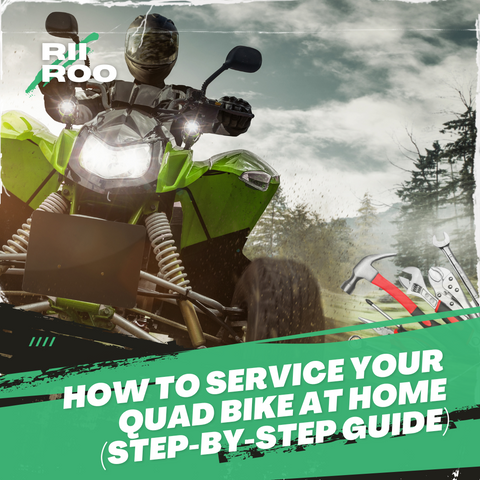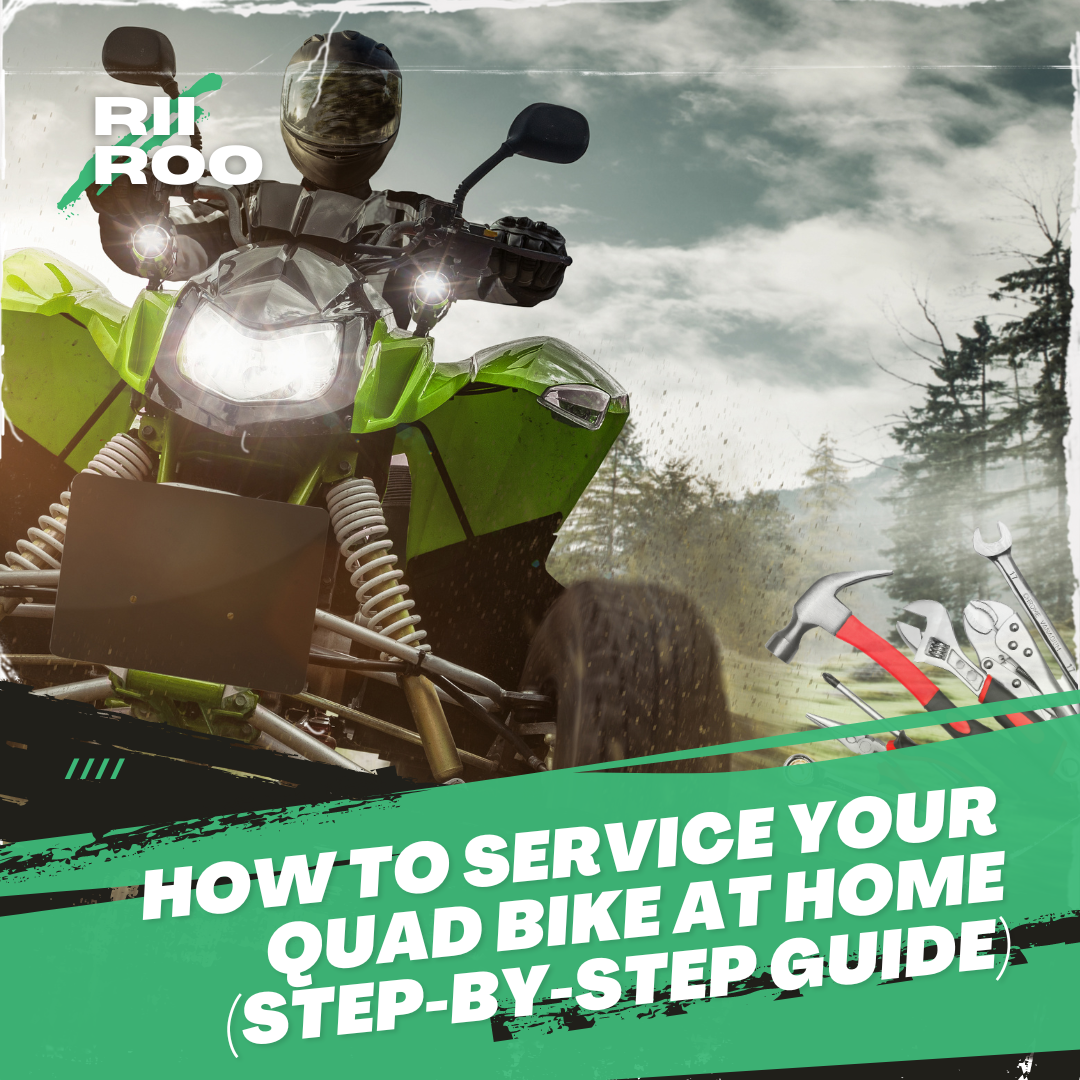Updated: 16.05.25

Owning a quad bike or planning to buy one? Regular servicing ensures safety, performance, and longevity for your quad bike or ATV. This 2025 guide offers a step-by-step approach to service your vehicle at home, complete with a maintenance checklist, repair tips, and cost estimates. Whether you’re maintaining a kids’ quad or a heavy-duty model, we’ve got you covered. New to quads? Explore our ultimate kids’ quad bike buyer’s guide.
1. Why Quad Bike Servicing Matters
Regular servicing prevents breakdowns, ensures rider safety, and extends your quad bike’s or ATV’s lifespan. It optimises performance on tough terrains like mud or hills and avoids costly repairs. Follow manufacturer guidelines in the owner’s manual and account for environmental factors like humidity or dust. Download our free quad bike maintenance checklist to track tasks easily.
| Component | Maintenance Task | Frequency |
|---|---|---|
| Engine Oil | Change oil and filter | Every 1000 miles or 100 hours |
| Air Filter | Clean or replace | Every 500 miles or 25 hours |
| Tyre Pressure | Check and adjust | Before every ride |
| Brakes | Inspect and service | Every 300 miles or 3 months |
| Chains | Lubricate and adjust | Every 500 miles or 3 months |
| Spark Plugs | Inspect and replace | Every 1000 miles |
Watch how to service a quad bike at home with basic tools.
2. How Often to Service Your Quad Bike or ATV
Maintenance Schedule and Checklist
Service frequency depends on usage, riding conditions, and quad type. Below is a detailed maintenance schedule to keep your quad bike or ATV in top condition:
- Initial Service: New quads require servicing three times within the first 1500 miles (2400 km) to ensure components settle properly.
- Lube Service: Lubricate chains and cables every 300 miles or 3 months.
- Air Filter Cleaning: Clean or replace every 500 miles or 25 hours to maintain engine efficiency.
- Oil and Filter Change: Perform a break-in change at 25 hours or 1 month, then every 1000 miles or 100 hours. See our oil change guide.
- Tyre Pressure Check: Verify pressure before every ride for safety and performance.
- Brake and Chain Checks: Inspect every 300 miles or 3 months for wear and tension.
- Spark Plug Checks: Inspect and replace every 1000 miles for optimal ignition.
- Bolt and Hinge Checks: Tighten every 40 hours to prevent loosening or rust.
- Chain Tension and Lubrication: Adjust and lubricate every 500 miles or 3 months.
Learn the importance of regular oil changes for quad bike maintenance.
Frequent or intense use (e.g., muddy terrains) requires more checks. For kids’ quads, prioritise safety with our kids’ quad bike safety features guide.
Discover safety features for kids’ quad bikes.
Factors Affecting Service Frequency
Several factors influence how often your quad bike or ATV needs servicing:
| Factor | Description |
|---|---|
| Frequency of Use | Daily use requires more frequent servicing. |
| Type of Use | Dusty or muddy conditions demand more maintenance. |
| Rider Weight | Heavier riders increase component wear. |
| Riding Style | Aggressive riding accelerates wear and tear. |
| Quad Bike Type | Design and use affect service needs; explore quad types. |
| Environmental Factors | Humidity and temperature impact maintenance frequency. |
| Maintenance History | Regular upkeep reduces issues; neglect increases repairs. |
3. Quad Bike Repair and Servicing Steps
Follow this step-by-step guide to service your quad bike.
Here’s how to service your quad bike or ATV at home, including tips for brands like Honda:
- Clean the Bike: Use low-pressure water and cloths to clean chains and cables, checking for rust and tension. For starting issues, see our starting guide.
- Tighten Components: Inspect and tighten all parts every 40 hours to ensure structural integrity.
- Check Brakes and Chains: Verify function every 300 miles or 3 months; adjust chain tension as needed.
- Change Oil and Filter: Perform break-in change at 25 hours or 1 month, then every 1000 miles or 100 hours. For Honda quads, use recommended oil types (e.g., 10W-30).
- Clean Air Filter: Clean or replace every 500 miles or 25 hours to protect the engine.
- Inspect Bolts and Hinges: Check for tightness and rust every 40 hours.
- Lubricate: Apply lubricant to chains and cables every 500 miles or 3 months to reduce wear.
- Build a Routine: Create a maintenance schedule to stay consistent.
- Store Properly: Keep in a cool, dry place to prevent damage.
Master riding a geared quad bike with our beginner’s guide.
4. Tools for Quad Bike Servicing
Equip yourself with these tools to service your quad bike or ATV effectively:
| Tool | Purpose |
|---|---|
| Combination Wrenches (8–32 mm) | Tighten bolts and nuts. |
| Screwdrivers (Flat, Phillips) | Remove and install screws. |
| Allen Wrenches (2.5 mm+) | Adjust hex bolts. |
| T-Handle Set | Access hard-to-reach areas. |
| Pliers | Handle small parts. |
| ATV Axle Wrench | Remove/install axle nuts. |
| Tyre Pressure Gauge | Monitor tyre pressure. |
| Tyre Plug Repair Kit | Fix punctures. |
| Socket Set | Remove/install parts. |
| Torque Wrench | Apply correct bolt torque. |
| Breaker Bar | Loosen tight bolts. |
| Mallet | Tap parts into place. |
5. Build a Servicing Routine
Create a tailored maintenance schedule based on usage (daily, weekly, or monthly). List tasks like oil changes, air filter cleaning, and brake checks, using the frequency guidelines above. Use calendars, apps, or digital reminders to stay on track. Keep records of services for future reference or resale. Adjust based on usage changes or issues noticed during checks. Download our maintenance checklist to simplify your routine.
6. Proper Quad Bike Storage
Store your quad bike or ATV in a cool, dry place to prevent rust and damage. Avoid outdoor exposure to sun, rain, or snow, which can harm paint and tyres. Use a high-quality waterproof cover if outdoor storage is unavoidable. Elevate the bike to prevent tyre flat spots, fill the fuel tank with a stabiliser, disconnect the battery, and cover the exhaust to deter pests. Not sure where to ride? Check our UK riding locations guide.
Proper storage protects your quad bike from damage.
7. Troubleshoot Common Quad Bike Issues
Learn to ride safely on various terrains with your kids.
Address common quad bike or ATV issues with these troubleshooting steps:
- Won’t Start: Check battery charge and connections, then inspect spark plug or fuel/air filter. For electric start issues, see our electric start guide.
- Flat Tyre: Use a tyre plug kit for minor punctures or replace severely damaged tyres.
- Overheating: Verify coolant levels and radiator condition; consult a professional if issues persist.
- Poor Acceleration: Clean or replace air filter, fuel lines, or carburettor; check fuel pump function.
- Brake Issues: Inspect and replace worn brake pads or discs for safe stopping.
- Chain/Cable Issues: Ensure chains and cables are clean, lubricated, and properly tensioned.
When to DIY vs. Call a Pro
DIY tasks like cleaning, tyre checks, or oil changes save money and are manageable with basic tools. Complex repairs, such as carburettor adjustments, brake disc replacements, or electrical diagnostics, often require professional expertise to avoid damage. For brand-specific needs (e.g., Honda quad servicing), consult your manual or a certified mechanic to ensure compatibility and safety.
For safe riding tips, check our terrain riding guide.
8. How Much Does Quad Bike Servicing Cost?
Servicing costs depend on whether you DIY or hire a professional, as well as the quad’s type and condition. Here’s a breakdown:
- DIY Servicing: £20–£50 for parts like oil (£5–£10), filters (£5–£15), and spark plugs (£5–£10). Tools (e.g., wrench set) may add a one-time cost of £50–£100.
- Professional Servicing: £100–£200 per session, including labour, parts, and diagnostics. Costs vary by location and repairs (e.g., brake replacement adds £50–£100).
- Factors Affecting Cost: Kids’ quads are cheaper to service than adult models; muddy or frequent use increases part wear; urban areas may have higher labour rates.
Save money by performing basic tasks yourself, buying parts in bulk, and shopping our quad bike deals for affordable options.
9. Finding Quad Bike Servicing Near You
Searching for “quad bike servicing near me”? Use platforms like Yelp, Google Reviews, or local directories to find reputable mechanics. Look for shops certified in ATV or quad bike repairs, with expertise in brands like Honda. Check reviews for reliability and ask about turnaround times. In the UK, our UK riding locations guide lists areas with nearby service centres. For DIY, stock up on parts from our quad bike collection.
10. Conclusion
Servicing your quad bike or ATV ensures safety, boosts performance, and extends its lifespan. Follow our maintenance checklist, repair tips, and storage advice for thrilling, worry-free rides in 2025. Explore petrol quad maintenance, teaching kids to ride, or choosing the best quad. Shop our quad bikes for top-quality petrol and electric models!
Teach kids the basics of quad bike riding safely.
Frequently Asked Questions
What is a quad bike maintenance checklist?
A quad bike maintenance checklist includes tasks like checking tyre pressure before rides, changing oil every 1000 miles, and cleaning air filters every 500 miles. It ensures all components stay in top shape. Download our free checklist for a complete guide.
Do quad bikes need an MOT?
Yes, quad bikes used on public roads require an MOT to meet safety and environmental standards. Browse our kids’ petrol quads for road-ready options.
Can I service my quad bike myself?
Basic tasks like cleaning, lubrication, and tyre checks are DIY-friendly with the right tools. Complex repairs (e.g., carburettor, brakes) often need professionals. Explore our kids’ electric quads for low-maintenance models.
How can I boost my quad bike’s performance?
Use high-quality fuel, maintain correct tyre pressure, tune the engine, and consider safe modifications like performance air filters or exhausts, following manufacturer guidelines.
How do I store my quad bike for winter?
Store in a dry, elevated place with a full tank, fuel stabiliser, disconnected battery, and covered exhaust. Use a waterproof cover. See our winter storage guide.
Additional Resources
- Quad Bike Oil Change Frequency
- Starting a Quad Bike
- Riding a Geared Quad Bike
- Choosing the Best Kids’ Quad Bike
- Kids’ Petrol Quads
- Kids’ Electric Quads
Get in Touch 🚀
Loved our quad bike servicing guide? Ready for more adventure?
Parents, we’ve got answers to all your quad bike questions! 🏍️
Visit RiiRoo.com or use our Live Chat to explore our quad bikes!










Share:
What Does CC Mean in Motorcycles? Learn About CC in Bikes?
What Size Dirt Bike Do You Need in 2025?